Exploring the Depths of Diamonds: Significance and Traits
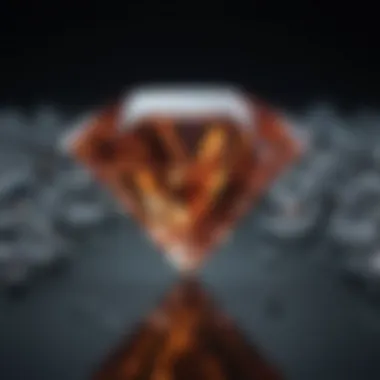
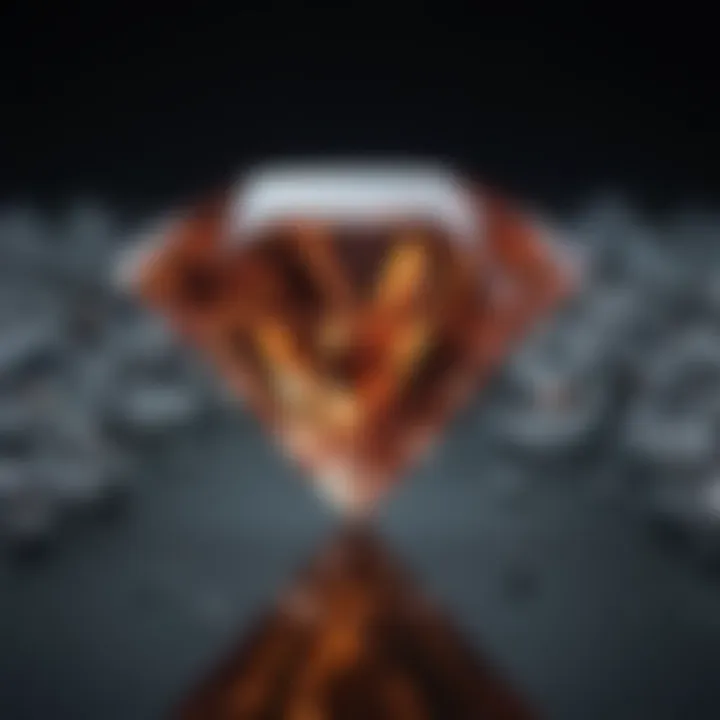
Intro
Diamonds have long fascinated both the general populace and experts alike. With their dazzling appearance and extreme durability, they are not merely stones but legends. Often associated with power, love, and eternity, diamonds have managed to weave themselves into the very fabric of human culture across generations and geography. But to truly appreciate their significance, it is essential to delve deeper than the surface glitter.
In this exploration, we'll get under the skin of diamonds, dissecting their defining characteristics—both physical and chemical. We won't shy away from discussing their rich cultural backgrounds and the ethical considerations that accompany their sourcing, providing a rounded perspective.
Let’s kick off this diamond journey by understanding what defines these precious stones.
Foreword to Diamonds
Diamonds, often associated with wealth and luxury, hold a unique place in human history and culture. From ancient myths to modern engagement rings, their allure transcends mere aesthetics. Understanding diamonds is not only about their beauty but also about their significance—scientifically, culturally, and socially. This section sets the stage for a deeper exploration into diamonds’ many facets, inviting readers into the profound world that these gemstones inhabit.
A diamond is formed deep within the Earth’s mantle under extreme pressure and high temperature. This natural process gives rise to a stone renowned not just for its hardness but for its remarkable brilliance. As we delve into their characteristics, we uncover not just a gemstone, but a symbol of endurance and permanence, often equated with lasting love and commitment. Despite their glamorous reputation, diamonds possess qualities that merit a closer look, such as their crystal structure and the chemical bonds that define them. This introduction aims to pique the interest of gemstone enthusiasts, collectors, and those who design exquisite jewelry.
Historical Context
The history of diamonds is as dazzling as the stones themselves. They’ve been part of human civilization for over a millennium, with their first known appearances in India. Once considered talismans believed to possess protective powers, early diamonds were often set into the armor of warriors, symbolizing strength and invincibility. They were more than ornamental; they were seen as objects of myth and magic.
Over time, diamonds became closely tied to nobility. In the Middle Ages, only royalty could afford to wear them. Their association with power is famously exemplified in the Hope Diamond, which has a storied past filled with intrigue and misfortune.
As trade routes expanded, diamonds made their way to Europe, cementing their status in the continent’s elite circles. This historical context enriches our understanding of how societal values attached these gemstones to emotions and significant life events, especially in engagements and marriages.
Modern Appeal
In contemporary society, diamonds are still synonymous with luxury, but their appeal has broadened significantly. The diamond industry has adapted to cultural shifts, emphasizing the emotional connection rather than just the monetary value. The phrase "A diamond is forever" is ever poignant in advertising, as it resonates with the significance placed on lasting love and commitment.
More recently, there’s been a growing awareness around the ethical sourcing of these precious stones. Consumers today are increasingly concerned about the origins of their diamonds, sparking a demand for conflict-free stones. This modern appeal is not only based on the beauty and brilliance of diamonds but also on the integrity of their sourcing.
Additionally, the rise of lab-grown diamonds is reshaping consumer perceptions. These alternatives offer a more ethically sound and often more affordable option without sacrificing quality or beauty. As such, modern diamonds have transformed from status symbols to expressions of individual values, aligning with personal beliefs and aesthetics.
Diamonds remain a captivating subject, infusing history, culture, and technology into one sparkling narrative. They tell stories that link our past to our present and pave the way toward a future where their significance evolves alongside the values of society.
Physical Characteristics of Diamonds
The allure of diamonds extends beyond their aesthetic appeal. Understanding the physical characteristics of these gemstones is essential not only for aficionados but also for industry professionals involved in mining, grading, and jewelry design. From their structural properties to their dazzling visual effects, the physical characteristics of diamonds play a pivotal role in defining their value and desirability.
Crystal Structure
Diamonds are renowned for their unique crystal structure, classifying them as a form of carbon arranged in a cubic lattice. This specific arrangement allows diamonds to exhibit remarkable qualities, contributing to their exceptional strength and visual allure. The solid lattice of carbon atoms forms a three-dimensional network that is a key to their unparalleled hardness—the hardest known natural material on Mohs scale.
This crystalline formation not only contributes to their durability but also influences how they reflect and refract light. In essence, it acts like a prism, which is essential for the sparkle we associate with high-quality diamonds. What’s fascinating is that the formation of diamonds can occur under extreme conditions deep within the Earth, at depths of approximately 150 to 250 kilometers, where they are subjected to intense pressure and heat. This geological process can take millions of years, emphasizing that each diamond tells a story of time and endurance.
Hardness and Durability
When talking about diamonds, their hardness is often the first quality that comes to mind. Not only are they rated a perfect 10 on the Mohs scale, but they also withstand scratching more effectively than any other gemstone. This incredible hardness makes diamonds ideal for everyday wear, particularly in engagement rings.
But hardness isn't the only factor to consider. Diamonds are also resistant to chipping and breaking, which means they maintain their structural integrity while being worn in various settings. In practical terms, this translates into several advantages:
- Longevity: Diamonds can last a lifetime when cared for properly, making them highly coveted for heirloom pieces.
- Resale Value: Their unmatched hardness often leads to a higher resale value compared to other gemstones, enhancing their appeal for collectors and investors.
- Versatility: Whether worn as jewelry or used in industrial applications, diamonds’ durability makes them incredibly versatile.
Brilliance and Fire
The brilliance of a diamond—its ability to reflect light—is another crucial physical characteristic that mesmerizes onlookers. This quality, known as brilliance, is determined by how light is absorbed and then reflected within the diamond. Factors like cut, shape, and proportions significantly influence how light interacts with the stone. A well-cut diamond harnesses light more effectively, resulting in a captivating sparkle that captivates attention.
Furthermore, the fire of a diamond refers to the colored flashes of light that it displays when exposed to a light source. This phenomenon occurs due to the diamond's unique ability to disperse light. The combination of brilliance and fire creates that irresistible dance of light, drawing people in and creating an emotional connection to the gemstone.
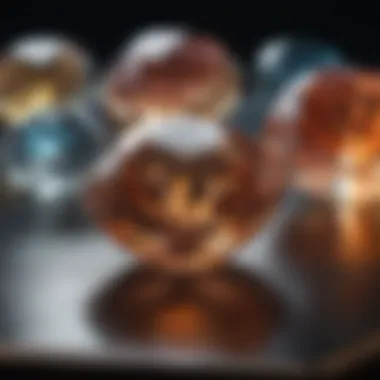
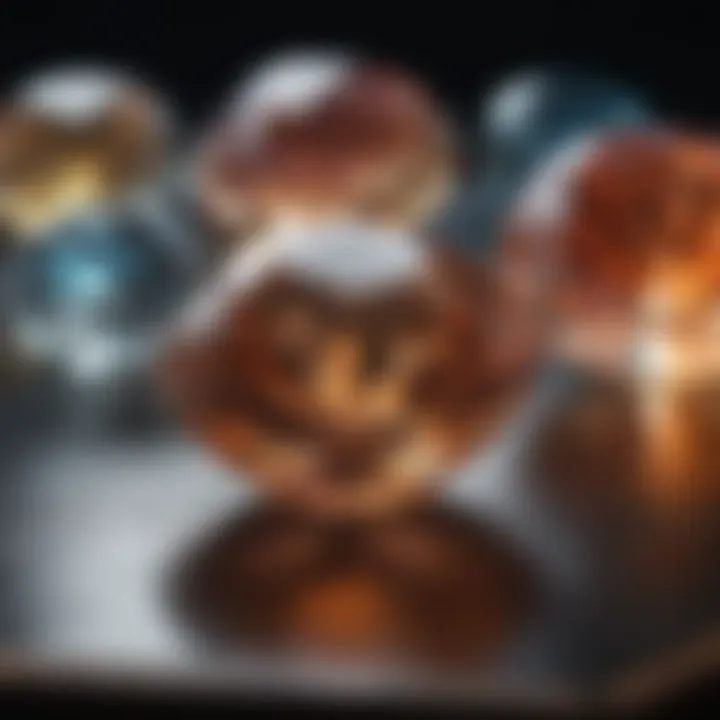
In summary, the physical characteristics of diamonds are not merely scientific distinctions. They are integral to the identity and perceived value of this exquisite gemstone, captivating all who encounter it.
Chemical Composition of Diamonds
Understanding the chemical composition of diamonds is pivotal for anyone keen on grasping both their physical allure and intrinsic value. Fundamentally, diamonds are made entirely of carbon, but the intricate nature of how these carbon atoms bond and arrange themselves gives rise to the gem's unique properties. The composition not only defines the diamond's hardness and brilliance but also influences its color and price, making it a subject of great importance for gemstone enthusiasts and jewelers alike.
Carbon Bonds
At the core of a diamond’s composition, carbon atoms are bonded together in a tetrahedral lattice structure, which is exceptionally stable. Each carbon atom forms four covalent bonds with neighboring carbon atoms, creating a three-dimensional network that results in one of the hardest materials known to man. This durable structure contributes to diamonds' renowned hardness rating of 10 on the Mohs scale, making them ideal for various applications beyond adornment, including cutting tools.
This unique bonding also plays a role in how diamonds interact with light. When light hits the diamond, it refracts due to the densely packed carbon atoms, which leads to the remarkable brilliance and fire that diamonds are celebrated for. The intricate nature of these carbon bonds showcases the gem's natural beauty—each turn and corner reflecting light in a dance that captivates the beholder.
"A diamond is a carbon, but it's the way those carbon atoms are arranged that makes all the difference. It’s the structure that transforms simple carbon into something precious and eternal."
Impurities and Color Variation
However, not all diamonds are created equal. Impurities in the diamond's chemical structure can significantly affect its appearance. The presence of trace elements, such as nitrogen, boron, or hydrogen, can alter the color of a diamond. For instance, the introduction of nitrogen can yield yellow diamonds, while boron can result in unique blue shades.
These color variations can also impact their market value. While colorless diamonds often command higher prices due to their rarity and desirability, colored diamonds can be equally sought after for their uniqueness. The nuances behind these variations highlight the complexity of diamond grading and valuation, where subtle differences in chemical elements translate to profound implications for aesthetic preference and resale value.
In summary,
- The role of carbon bonds is fundamental to a diamond's physical properties.
- Impurities lead to an array of diamond colors and contribute to their marketability.
By understanding these chemical aspects, enthusiasts and professionals gain a deeper appreciation of these gems, allowing for better choices when investing in or designing with diamonds.
Cultural Significance of Diamonds
The cultural significance of diamonds stretches far beyond their glimmering surface and dazzling appearance. For centuries, cultures around the world have imbued these stones with meanings that transcend mere economics. Diamonds, in many societies, symbolize eternity, strength, and wealth, but their representations carry subtleties unique to each culture. Recognizing the cultural insights diamonds offer is crucial for gaining a holistic understanding of why they hold such esteemed positions in human affection and tradition.
Through their presence in mythology and folklore, diamonds have woven themselves into the very fabric of various cultures. Here we will delve into two specific areas: their mythological connections and their symbols across different societies.
Diamonds in Mythology
In many myths and legends, diamonds hold a sacred place, often viewed as gifts from the gods or as pieces of celestial power. For instance, in ancient Indian texts, diamonds were believed to be created from lightning bolts that struck the mountains, hence possessing divine energy. Similarly, in medieval Europe, diamonds were thought to repel evil and were worn as talismans to protect against harm. The association of diamonds with myths is rich and varied, providing insights into how ancient peoples viewed these stones as sacred elements in their worldview.
Moreover, their perceived magical properties often led to the belief that diamonds could bring good fortune, wisdom, and strength to their bearers. The legend of the diamond in the rough is often cited as an example of the untold potential and inner beauty that can emerge from hardship, resonating with the human experience of growth and transformation.
"In the end, they all return to the earth, but the stories they carry are written in the light of a thousand stars."
Symbolism in Different Cultures
The symbolism of diamonds varies remarkably between cultures, reflecting differing values, practices, and beliefs. In Western cultures, diamonds are predominantly associated with love and commitment, especially as engagement rings. This tradition solidified in the 20th century, thanks largely to marketing campaigns which linked diamonds with romantic proposals. The enduring phrase "A diamond is forever" underscores this belief, suggesting that true love is resilient, unbreakable, and eternal.
In contrast, African cultures often link diamonds with power and status. Some tribal leaders historically adorned themselves with diamonds as a demonstration of their wealth and authority. In India, diamonds have been associated with royalty and are often part of ceremonial attires, reflecting the opulence of the sovereign class.
Additionally, in Eastern philosophies, such as Buddhism, diamonds symbolize enlightenment and unyielding strength, showcasing the dual nature of their characteristics. The term "vajra", which translates to 'diamond' in Sanskrit, represents the indestructible and brilliant nature of spiritual insight.
Overall, the cultural significance of diamonds reveals a complex weave of meanings. From being seen as symbols of love in the West to demarcations of authority in Africa, the multifaceted narratives surrounding diamonds continue to influence their perception across time and space. Understanding these varying significances allows us to appreciate not just the beauty of diamonds, but also the rich tapestry of human beliefs and traditions they embody.
Diamonds in Art and Literature
Diamonds have held a unique allure in art and literature, serving not just as luxurious objects but as profound symbols and narrative devices. Their physical brilliance tends to captivate artists and writers, weaving them deeply into the fabric of storytelling and visual representation. To understand their significance in this realm, we can examine both the distinct works that feature diamonds prominently and the metaphorical weight they often carry in literature.
Iconic Works Featuring Diamonds
Numerous artworks and literary pieces highlight diamonds in striking ways. Take, for instance, the famous painting "The Virgin of the Rocks" by Leonardo da Vinci, which showcases diamonds alongside other precious stones to convey divinity and wealth. The contrast between the gems and the serene expression of the Virgin adds layers to the narrative.


In literature, diamonds frequently appear as central elements in stories of ambition and desire. A quintessential example is "The Great Gatsby" by F. Scott Fitzgerald, where the character Daisy Buchanan is associated with the luxury of diamonds. Her charm and elusive persona underscore themes of aspiration and the American Dream, making the diamond a powerful metaphor for unattainable beauty and social status.
Beyond these famous examples, diamonds serve to evoke strong emotions and ideals in various art forms. They become metaphors for wealth and sometimes for the burden that comes with it. Whether through sculptures or poems, the diamond often stands as a dual symbol of beauty and fear—captivating yet demanding.
Diamonds as Metaphor
The metaphorical use of diamonds is rich and varied. Often, they embody the duality of human experience—their hardness speaks to resilience, while their clarity symbolizes truth. In poetry, for instance, diamonds might represent purity amidst chaos, a striking contrast that captivates the reader's imagination. A well-known line might read, "Her love was like a diamond—hard yet so clear, a treasure to behold."
In contemporary discussions, diamonds can also reflect the complexities of morality, particularly in the context of ethical sourcing. As narratives around conflict diamonds emerge, the metaphor extends further, raising questions about value versus ethics. A beautiful diamond, then, might also represent a painful history, prompting deeper reflection on our consumer choices and the stories behind each gem.
"Diamonds are not just material; they are reflections of our societal values and human experiences."
Metaphysical Properties of Diamonds
When one thinks about diamonds, the first images that often come to mind are of shimmering beauty and luxury. However, the diamond's value extends far beyond the surface, delving into metaphysical realms that many might overlook. Understanding the metaphysical properties of diamonds is vital for those who appreciate not just their aesthetic charm but also their potential to influence our lives on various levels. From holistic healing practices to spiritual enlightenment, diamonds carry a significance that resonates through ages and cultures.
Healing Qualities
Diamonds are often referred to as powerful healing stones, believed to possess the ability to enhance the energies surrounding the wearer. Many proponents argue that they help alleviate stress and improve overall emotional health. It is said that when one holds or wears a diamond, it fosters clarity of thought, enabling individuals to navigate through emotional turbulence more effectively.
- Energy Amplification: Diamonds amplify energy and intention, making them a choice for those engaging in meditation or personal growth. Their capacity to enhance other stones' properties when paired with them is noteworthy.
- Emotional Balance: The belief prevails that wearing diamonds aids in balancing one’s emotions and supports overcoming grief and anxiety. Users often share experiences of feeling more grounded and centered.
- Physical Healing: In some alternative practices, diamonds are credited with having a healing vibration that may positively affect the physical body. Some energy healers assert that they assist in strengthening the immune system and promoting overall wellbeing.
"The diamond stands not just as a symbol of beauty, but as a beacon of light guiding the heart and soul towards healing and clarity."
Spiritual Significance
The metaphysical allure doesn’t stop at healing; diamonds carry profound spiritual significance as well. Various cultures and belief systems have revered diamonds, considering them to be a bridge between the earthly realm and the divine.
- Spiritual Awakening: Diamonds can symbolize spiritual awakening. Their clear nature serves as a metaphor for transparency and purity, inspiring the wearer to seek deeper truths and connect with higher consciousness.
- Protection and Strength: Many traditions align diamonds with protective energies against negativity. It is believed that diamonds shield the wearer from harmful energies, thus allowing for safer exploration of spiritual paths.
- Connection to Cosmic Forces: Some spiritual practitioners view diamonds as conduits to cosmic energies, suggesting that they enhance intuition and psychic abilities. Wearing diamonds is thought to facilitate a stronger connection to the universe's mysteries.
Through their multifaceted roles—whether aiding in healing or spiritual exploration—diamonds resonate with those who seek depth beyond their brilliance. Understanding these properties enriches our appreciation of these gems, transforming them from mere adornments into powerful talismans.
The Diamond Industry
The diamond industry is a multifaceted arena that embodies economic, cultural, and ethical dimensions crucial for understanding the broader significance of diamonds. From the early days of diamond trading to the modern challenges faced in ethical sourcing, this industry reflects the complexities of supply and demand, environmental impacts, and societal changes.
Mining and Extraction
Mining and extraction remain at the heart of the diamond industry, directly influencing its economic viability. Traditionally, diamonds are sourced from two primary methods: alluvial mining and kimberlite mining. Alluvial mining involves sifting through riverbeds or ocean floors where diamonds might have been deposited over time. It's a more labor-intensive method, often relying on manual labor and small-scale operations. In contrast, kimberlite mining occurs in deep, volcanic pipes where diamonds form. This method is generally large-scale, utilizing heavy machinery and significant investment.
However, the impact of these practices on the environment cannot be overlooked. The extraction processes can lead to deforestation, soil erosion, and disruption of ecosystems. In areas like Botswana, where advanced technologies help mitigate some environmental impacts, the conversation shifts towards sustainable practices that balance profitability with responsibility.
Moreover, the communities surrounding these mining sites often face socioeconomic dilemmas. While mining can create job opportunities, it can also lead to exploitation and inequities. The industry's development has raised questions about the need for corporate social responsibility measures and transparent practices to ensure benefits reach local communities.
Market Dynamics
The market dynamics of the diamond industry are influenced by a complex web of factors, which include global economic conditions, consumer behavior, and emerging alternatives like lab-grown diamonds. As society becomes more aware of ethical sourcing, consumer preferences are shifting. Many collectors and jewelry buyers are now looking for assurance regarding the origins of their diamonds. This change is leading to increased demand for conflict-free and ethically sourced diamonds, putting pressure on the industry to adapt its supply chains.
Additionally, technological advancements have revolutionized the industry, influencing production processes and valuation. Lab-grown diamonds have burgeoned in popularity, presenting a challenge to natural diamonds by offering a more sustainable and often less expensive alternative. This shift is not merely a trend; it's reshaping conversations around luxury and value in today’s market.
Understanding the diamond market includes recognizing cyclical fluctuations; periods of economic downturn often affect luxury purchases. Furthermore, cultural factors also play a role, as weddings and engagements influence diamond sales. In many cultures, diamonds hold a significant place in traditions and celebrations, further anchoring their relevance in the market.
"The diamond industry is not just about beautiful stones; it's a reflection of human desires, ethical dilemmas, and technological progress."
The diamond industry encompasses more than just the precious gemstones. Through its mining practices and market dynamics, it invites discussions on sustainability, technological change, and cultural significance. It is essential for gemstone enthusiasts and collectors to remain vigilant regarding these developments. Understanding the complexities involved enriches the appreciation for diamonds and their journeys from the earth to luxury jewelry.
Ethical Sourcing and Sustainability
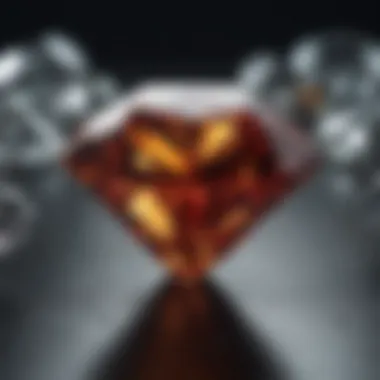
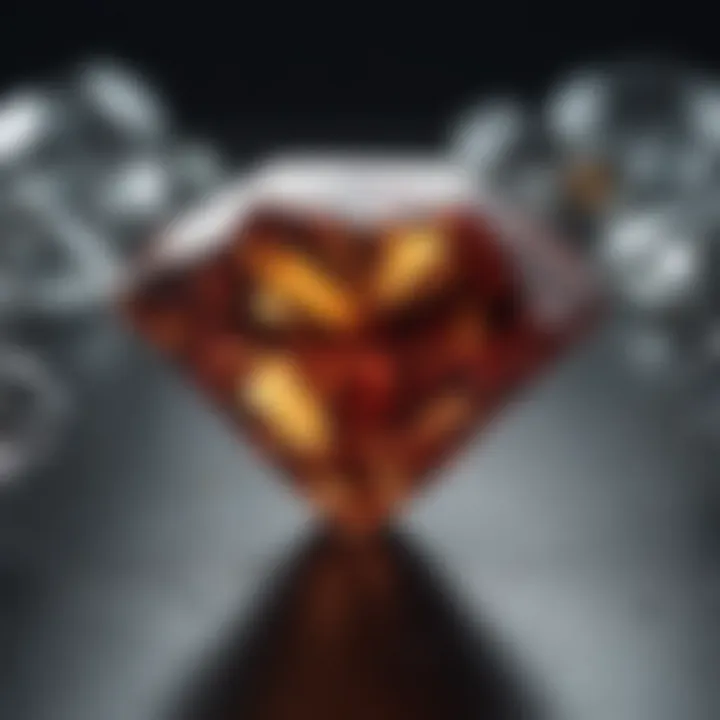
In recent years, the dialogue surrounding diamonds has shifted significantly, placing ethical sourcing and sustainability at the forefront of discussions. This transformation is crucial not only for the planet but also for the integrity and reputation of the diamond industry. Ethical sourcing seeks to ensure that diamonds are mined, traded, and sold in ways that do not contribute to human suffering or environmental damage. It emphasizes transparency and responsibility throughout the entire supply chain, fostering a sense of trust between consumers and vendors.
Together with sustainability, which encompasses the environmental aspects of diamond production, these principles alter the landscape of the diamond market and guide its future prospects.
Conflict Diamonds and Their Impact
Conflict diamonds, commonly known as blood diamonds, have left a dark mark on the diamond industry. These stones are mined under conditions that often involve human rights abuses, forced labor, and violence. The profits from conflict diamonds have funded armed conflicts, leading to devastating social and economic consequences in affected countries, particularly in parts of Africa.
The global community has recognized the urgency of this issue, giving rise to initiatives like the Kimberley Process Certification Scheme, which aims to prevent the trade of conflict diamonds. However, criticisms regarding its effectiveness have also emerged, highlighting loopholes that allow some conflict diamonds to still reach the market. Consequently, consumers are increasingly motivated to be aware of the source of their diamonds, paving the way for more ethical purchasing decisions.
The impact of conflict diamonds extends beyond the gems themselves—as it invokes broader questions about morality and civic responsibility. By choosing ethically sourced stones, buyers play a pivotal role in shaping the industry's ethical landscape.
Sustainable Practices in Mining
Sustainable practices in diamond mining are vital for minimizing environmental damage and promoting social equity in mining communities. Approaches such as land rehabilitation, reduction of carbon footprints, and fair labor practices have begun gaining traction among responsible diamond producers.
Key sustainable practices include:
- Land Restoration: Rehabilitating mining sites post-extraction helps to restore natural ecosystems and support local biodiversity.
- Water Management: Implementing techniques to minimize water usage and prevent contamination of local water sources ensures that mining operations do not disrupt communities.
- Community Engagement: Involving local communities in decision-making processes and ensuring fair compensation for their land and resources can bolster social stability and economic growth.
- Certification Schemes: Authenticating ethically mined diamonds through certifications aids consumers in making informed choices and encourages brands to adopt ethical practices.
Through these sustainable practices, the diamond mining industry can evolve into a model of ethical consumption, promoting fairness and respect for the environment. As consumer awareness grows, companies that embrace sustainable and ethical mining will find increasing favor in the market, making it not only a moral choice but also a savvy business one.
"The choices we make today shape the world we live in tomorrow."
In summary, addressing the challenges of conflict diamonds and adopting sustainable practices fortifies the foundation for a more accountable diamond industry. It is imperative for both consumers and producers to engage in this transformative movement, ensuring that the allure of diamonds includes responsibility and integrity.
Diamond Grading and Value Assessment
Grading diamonds is a crucial part of understanding their value and ensuring transparency in the buying process. For gemstone enthusiasts, collectors, jewelry designers, and geology lovers, comprehending how diamonds are graded empowers them to make informed decisions. This section uncovers the fundamental aspects of diamond grading, elucidating its benefits and considerations.
The Four Cs: Cut, Color, Clarity, Carat
When it comes to assessing a diamond's worth, the Four Cs are your best friends: Cut, Color, Clarity, and Carat weight. Each attribute plays a pivotal role in the overall quality and thus its value.
- Cut: The way a diamond is cut influences how it reflects and refracts light - this is what gives it that dazzling sparkle. A well-cut diamond will appear brighter and more radiant compared to a poorly cut stone, regardless of other qualities. This aspect is often the most important and can determine up to 50% of a diamond's value.
- Color: Diamonds come in a range of colors, but the most prized are colorless or near-colorless stones. The grading ranges from D (colorless) to Z (light yellow or brown). Generally, the closer a diamond is to being colorless, the more valuable it becomes. That said, fancy colored diamonds, like blue or pink, can command even higher prices due to their rarity.
- Clarity: This metric evaluates the presence of inclusions or blemishes. A diamond with fewer imperfections is rare and thus more valuable. Clarity grades range from Flawless to Included. Even the tiniest speck can affect both beauty and price, making this aspect essential when grading diamonds.
- Carat: Finally, carat weight provides a direct measure of a diamond's size. A common misconception is that larger diamonds are always better. However, a smaller diamond of exceptional cut, color, and clarity can be more desirable than a larger stone that compromises on those factors. It's about quality over mere size.
"It’s not the size of the stone that matters; it’s how it sparkles that counts."
This assessment of the Four Cs brings to light how nuanced and complex the world of diamonds can be. Understanding these elements allows collectors and enthusiasts to appreciate the craftsmanship and natural beauty inherent in each gem, aligning their choices with what they value most.
Market Trends and Valuation
The diamond market is dynamic, influenced by various factors including economic conditions, cultural trends, and shifting consumer preferences. Evaluating market trends is vital for anyone looking to invest in or sell diamonds.
- Economic Influences: In times of economic buoyancy, luxury items like diamonds often see a spike in demand. Conversely, during downturns, prices tend to stabilize or drop.
- Cultural Shifts: Recent years have seen a move towards more customized jewelry options, leading to higher valuations for unique or bespoke pieces. Consumers are now more inclined to seek authenticity, which can lead to a greater appreciation for lab-grown stones alongside natural diamonds.
- Technological Innovations: The rise of online marketplaces has shifted how diamonds are priced and sold. Transparency in pricing has become more standard, with the value of diamonds being assessed based on competitive online inventories.
- Investing Trends: Diamonds are increasingly viewed as alternative investments, similar to art or fine wines. This perspective can inflate values, particularly for rarer stones, but it also requires potential investors to stay educated and informed.
To stay abreast of market fluctuations, it's essential for enthusiasts and collectors to engage with various platforms discussing diamond valuation. Resources like Wikipedia, Britannica, or even forums like Reddit can clear the fog of uncertainty.
Future of Diamonds
The evolution of diamonds is a tale that's constantly unfolding. Diamonds, once reserved for the elite, are now experiencing a transformation shaped by technological advancements and changing consumer preferences. The concept of diamonds has indeed evolved, and this will be the focus of our discussion here. Understanding the future of diamonds is crucial, not only for enthusiasts and collectors but also for those involved in the jewelry-making industry and the mining community. As we look ahead, several significant elements emerge that shape this bright future.
Lab-Grown Diamonds
Lab-grown diamonds have emerged as a game-changer in the diamond industry. These gemstones are created in controlled environments using advanced technological processes that mimic the natural conditions under which diamonds form. Lab-grown diamonds share identical physical, chemical, and optical properties with naturally mined diamonds, yet they often come at a fraction of the cost. While there’s been some debate about their value compared to natural diamonds, their rise in popularity is undeniable and comes with some compelling benefits:
- Ethical Considerations: The debates surrounding conflict diamonds have propelled many buyers to consider alternative options. Lab-grown diamonds are certified free from ethical concerns associated with traditional mining.
- Sustainability: These diamonds usually have a lower environmental impact compared to mined diamonds. They don’t contribute to the disturbances typical of high-scale mining operations.
- Customization: Lab-grown diamonds can be produced in an array of shapes and sizes, allowing consumers to customize their selections according to personal preferences.
It’s important to note that while lab-grown diamonds offer significant advantages, there are still sentiments attached to natural diamonds that may take time to shift. For some, the story and the history embedded in a natural diamond hold intrinsic value far beyond its physical attributes.
Technological Innovations in Diamond Processing
The technological advancements affecting diamond processing are revolutionizing production and establishing more efficient methods of cutting, polishing, and evaluating diamonds. Innovations such as artificial intelligence and machine learning are being integrated into the diamond industry. Here are key factors to consider:
- Enhanced Precision: Advanced machinery can assess the quality of diamonds with unmatched precision. This allows jewelers to optimize cuts for maximum brilliance and fire, which enhances the ultimate appearance of the diamond.
- Rapid Processing: Automation and AI-driven systems significantly reduce the time taken for diamond processing, which could lead to cost reductions for consumers.
- 3D Visualization: Cutting-edge modeling software helps gemologists visualize and plan the ideal shape of a diamond before the cutting begins. This technology fosters creativity and allows for innovative designs that capture a wider audience.
"The integration of technology into diamond processing not only increases efficiency but also enhances the overall quality and appeal of the diamonds produced."
The future of diamonds is undoubtedly filled with potential. As the landscape of diamond mining and processing evolves, it is essential for enthusiasts, collectors, and anyone in the field to stay informed. With lab-grown diamonds expanding options for consumers and technological advancements influencing processing, we are witnessing a significant shift that may very well redefine the diamond's place in our society.



